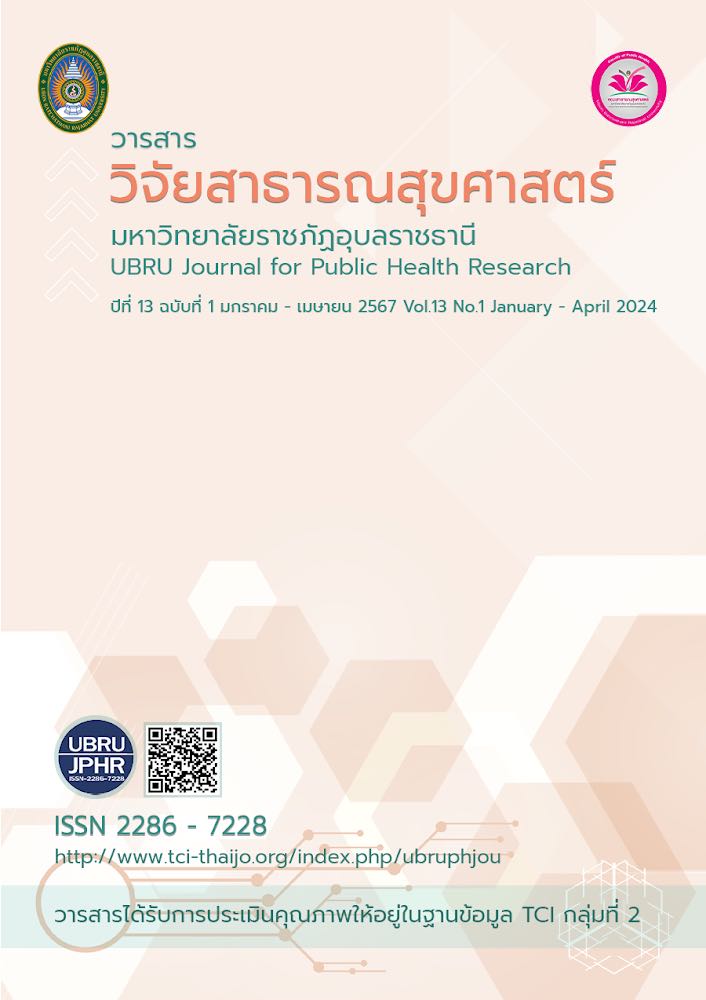ปัจจัยที่มีความสัมพันธ์ต่อการตัดสินใจใช้สมุนไพรรักษาอาการเจ็บป่วยในช่วงที่มีการระบาดของโรคติดเชื้อโคโรนาไวรัส-2019 ของประชาชนในเขตพื้นที่ ตำบลนาอ้อ อำเภอเมือง จังหวัดเลย
คำสำคัญ:
การตัดสินใจใช้สมุนไพร, โรคติดเชื้อโคโรนาไวรัส-2019, สาธารณรัฐประชาธิปไตยประชาชนลาวบทคัดย่อ
การศึกษาครั้งนี้มีวัตถุประสงค์เพื่อศึกษาระดับความรู้ ทัศนคติและศึกษาปัจจัยที่มีความสัมพันธ์กับการตัดสินใจใช้สมุนไพรรักษาอาการเจ็บป่วยในช่วงที่มีการระบาดของโรคติดเชื้อโคโรนาไวรัส-2019 ของประชาชน กลุ่มตัวอย่างคือ ประชาชนตำบลนาอ้อ อำเภอเมือง จังหวัดเลย จำนวน 243 คน เครื่องมือที่ใช้ในการวิจัยเป็นแบบสอบถาม วิเคราะห์ข้อมูลส่วนบุคคล ความรู้ และทัศนคติ โดยใช้สถิติเชิงพรรณนา และวิเคราะห์ความสัมพันธ์โดยใช้สถิติไคสแควร์
ผลการวิจัยพบว่า กลุ่มตัวอย่างส่วนใหญ่ มีความรู้เกี่ยวกับการใช้สมุนไพร อยู่ในระดับสูง ร้อยละ 69.1 มีทัศนคติเกี่ยวกับการใช้สมุนไพรอยู่ในระดับปานกลาง ร้อยละ 58.0 และปัจจัยที่มีความสัมพันธ์กับการตัดสินใจใช้สมุนไพรรักษาอาการเจ็บป่วย ได้แก่ รายได้เฉลี่ยต่อเดือน (c2=8.848, p=0.012) การได้รับข่าวสารจากเจ้าหน้าที่ด้านสุขภาพ (c2=16.180, p<0.001) และหอกระจายข่าวของหมู่บ้าน (c2=4.833, p =0.028) อาการเจ็บคอ (c2 = 3.938, p=0.047) และทัศนคติ (c2=17.904, p<0.001)
ผลการวิจัยชี้ให้เห็นว่า รายได้ การได้รับข้อมูลข่าวสารจากเจ้าหน้าที่ด้านสุขภาพ หอกระจายข่าวของหมู่บ้าน และทัศนคติมีความสัมพันธ์กับการตัดสินใจใช้สมุนไพรรักษาอาการเจ็บป่วย ดังนั้นหน่วยงานที่เกี่ยวข้องควรจัดกิจกรรมที่ส่งเสริมให้ประชาชนเกิดทัศนคติที่ดีต่อสมุนไพร โดยเจ้าหน้าที่ด้านสุขภาพอาจใช้การสื่อสารผ่านหอกระจายของหมู่บ้าน เพื่อให้ประชาชนตัดสินใจใช้สมุนไพรรักษาอาการเจ็บป่วยของตนเองเพิ่มมากขึ้น
เอกสารอ้างอิง
กระทรวงสาธารณสุข. (2560). แผนแม่บทแห่งชาติ ว่าด้วยการพัฒนาสมุนไพรไทย ฉบับที่ 1 พ.ศ. 2560 – 2564. ค้นเมื่อ 20 ตุลาคม 2565, จากhttps://www.dtam.moph.go.th/images/download/dl0021/MasterPlan-Thaiherb.pdf
กรมวิทยาศาสตร์การแพทย์ กระทรวงสาธารณสุข. (2565). ข้อมูลการจำแนกตามสายพันธุ์ที่ต้องเฝ้าระวังและการกลายพันธุ์ของเชื้อ ณ 17 ตุลาคม 2565. ค้นเมื่อ 4 พฤศจิกายน 2565, จาก https://www3.dmsc.moph.go.th/post-view/1708
กุสุมาลย์ น้อยผา, วิทวัส หมาดอี, ปัชชาพร ราวียา และพิมพ์วิภา เกิดสุข. (2565). ปัจจัยที่มีความสัมพันธ์กับพฤติกรรมการใช้สมุนไพรป้องกันโควิด 19 ของประชาชนในอำเภอเมือง จังหวัดกระบี่. วารสารหมอยาวิจัยไทย. 8(2): 59 – 80.
ทัศดาพร แจวิจารณ์, ณัฏฐณิชา สนั่นก้อง, นัซมีน เจ๊ะกา, สุกาญจนา กำลังมาก, และ ยมล พิทักษ์ภาวศุทธิ. (2566). ปัจจัยที่มีความสัมพันธ์กับพฤติกรรมการใช้สมุนไพรเพื่อดูแลสุขภาพในสถานการณ์โควิด-19 ในนิสิตมหาวิทยาลัยทักษิณ วิทยาเขตพัทลุง. วารสารวิจัยและพัฒนาระบบสุขภาพ. 16(2), 60–73.
นภสร ผ่องใส, ชวลิน อินทร์ทอง, ดวงทิพย์ สนธิเมือง, ภัทรศศิรเหล่าจีนวงค์ และบดินทร์ ชาตะเวที. (2564). ปัจจัยที่มีความสัมพันธ์ต่อพฤติกรรมการใช้ฟ้าทะลายโจรในการดูแลสุขภาพ ช่วงภาวะติดเชื้อโควิด-19 ของประชาชนในอำเภอหาดใหญ่ จังหวัดสงขลา. วารสารไทยไภษัชยนิพรธ์. 17(1): 57-69.
บุญชม ศรีสะอาด. (2538). วิธีการทางสถิติสำหรับการวิจัย. พิมพ์ครั้งที่ 2. กรุงเทพฯ: สำนักพิมพ์อักษรกราฟฟิคแอนด์ดีไซน์.
บุญเลี้ยง สุพิมพ์, อรทัย ปานเพชร, มธุรส ชลามาตย์, นรุวรรณ อยู่สำราญ และ ปิยะพงษ์ ชุมศรี. (2566). ปัจจัยที่มีความสัมพันธ์ต่อการเลือกใช้สมุนไพรในการดูแลสุขภาพตนเองของประชาชนบ้านสวนห้อม ตำบลปวนพุ อำเภอหนองหิน จังหวัดเลย. วารสารวิจัยสาธารณสุขศาสตร์ มหาวิทยาลัยราชภัฏอุบลราชธานี. 12(2), 36 – 46.
ปาลิกา เวชกุล, วิริญญา เมืองช้าง, และ จุฑารัตน์ ภูบรรทัด. (2564). ปัจจัยที่มีความสัมพันธ์กับพฤติกรรมการใช้พืชสมุนไพร พื้นบ้านในการดูแลสุขภาพเบื้องต้นของอาสาสมัครสาธารณสุขประจำหมู่บ้าน ตำบลแม่ไร่ อำเภอแม่จัน จังหวัดเชียงราย. วารสารวิจัยราชภัฏเชียงใหม่. 22(3), 159–173.
พัชราพร หัตถิยา, ธีระวุธ ธรรมกุล, และอนัญญา ประดิษฐปรีชา. (2566). ปัจจัยที่มีผลต่อพฤติกรรมการใช้สมุนไพรในการดูแลสุขภาพของประชาชนเขตอำเภอเมือง จังหวัดนครศรีธรรมราช. วารสารกฎหมายและนโยบายสาธารณสุข. 9(2), 285–295.
ภิษณี วิจันทึก. (2562). ความรู้ ทัศนคติ และพฤติกรรมการใช้ผลิตภัณฑ์สมุนไพรของประชาชนบ้านหนองบัวศาลา อำเภอเมือง จังหวัดนครราชสีมา. วารสารวิชาการสาธารณสุข. 28(2), 244–254.
สามารถ ใจเตี้ย, ศศิกัญญ์ ผ่องชมพู และชัชญา สมมณี. (2565). ภูมิปัญญาและปัจจัยที่มีความสัมพันธ์กับ การใช้ประโยชน์สมุนไพรพื้นบ้านเพื่อดูแลสุขภาพ กรณีศึกษา: ชุมชนสะลวง-ขี้เหล็ก อำเภอแม่ริม จังหวัดเชียงใหม่. วารสารวิทยาศาสตร์และเทคโนโลยี, 30(2): 23-26.
สุวภี กลีบบัว, เจริญศรี ยอมเจริญ, และ อรพินธ์ สุชาติ. (2564). ปัจจัยที่มีความสัมพันธ์กับพฤติกรรมการใช้สมุนไพรในการดูแลสุขภาพตนเองของประชาชนในเขตอำเภอเมือง จังหวัดลำปาง. วารสารการบริหารนิติบุคคลและนวัตกรรมท้องถิ่น. 7(1), 195–209.
วิริญญา เมืองช้าง. (2559). ปัจจัยที่มีความสัมพันธ์กับพฤติกรรมการใช้สมุนไพรในการดูแลสุขภาพตนเองของประชาชนในอำเภอแม่ใจ จังหวัดพะเยา. วิทยานิพนธ์ปริญญาสาธารณสุขศาสตรมหาบัณฑิต สาขาวิชาการจัดการการสร้างเสริมสุขภาพ คณะสาธารณสุขศาสตร์ มหาวิทยาลัยธรรมศาสตร์.
ศูนย์ COVID-19 สำนักงานจังหวัดเลย. (2565). ข้อมูลสถานการณ์โรคติดเชื้อโคโรนาไวรัส – 2019 จังหวัดเลย. ค้นเมื่อ 20 ตุลาคม 2565, จาก https://covid.loei.go.th/frontpage
Arumugam, N. (2019). Knowledge, attitudes and practices (KAP) towards medicinal plants among Malaysian Consumers. Med Aromat Plants (Los Angeles). 8, 341.
Blooms, B. S., Hastings, J. T., & Madus, G. F. (1971). Handbook on formative and summative evaluation of student learning. 1st ed. New York: McGraw-Hill. 923.
Kristianto, H., Pramesona, B. A., Rosyad, Y. S., Andriani, L., Putri, T. A. R. K., & Rias, Y. A. (2022). The effects of beliefs, knowledge, and attitude on herbal medicine use during the COVID-19pandemic: A cross-sectional survey in Indonesia. F1000Research. 11: 483.
Likert, R. (1967). The Method of constructing attitude scale. In Reading in Fishbein. New York: Wiley & Son.
Tran, V. D., Tran, V. D., Pham, D. T., Cao, T., Bahlol, M., Dewey, R. S., … Nguyen, V. A. (2022). Perspectives on COVID-19 prevention and treatment using herbal medicine in Vietnam: A cross-sectional study. Annali di igiene: medicina preventiva e di comunita, 34(5): 515–531.
Villena-Tejada, M., Vera-Ferchau, I., Cardona-Rivero, A., Zamalloa-Cornejo, R., Quispe-Florez, M., Frisancho-Triveño, Z., … Yañez, J. A. (2021). Use of medicinal plants for COVID-19 prevention and respiratory symptom treatment during the pandemic in Cusco, Peru: A cross-sectional survey. PloS one, 16(9): e0257165.
Wayne, W. D. (1995). Biostatistics: A Foundation of Analysis in the Health Science. 6thed. John Wiley & Sonc. Inc., 180.
World Health Organization. (2023). Coronavirus disease (COVID-19): Situation reports. Retrieved December 6, 2023, from https://www.who.int/emergencies/diseases/novel-coronavirus-2019/situation-reports
World Health Organization; Thailand. (2023). WHO Thailand situation report – 266. Retrieved December 6, 2023, from https://www.who.int/thailand/news/detail/05-07-2023-the-situation-report-on-covid19
ดาวน์โหลด
เผยแพร่แล้ว
รูปแบบการอ้างอิง
ฉบับ
ประเภทบทความ
สัญญาอนุญาต
ลิขสิทธิ์ (c) 2024 คณะสาธารณสุขศาสตร์ มหาวิทยาลัยราชภัฏอุบลราชธานี

อนุญาตภายใต้เงื่อนไข Creative Commons Attribution-NonCommercial-NoDerivatives 4.0 International License.
เนื้อหาและข้อมูลในบทความที่ลงตีพิมพ์ในวารสารวารสารวิจัยสาธารณสุขศาสตร์ มหาวิทยาลัยราชภัฏอุบลราชธานี ถือเป็นข้อคิดเห็นและความรับผิดชอบของผู้เขียนบทความโดยตรงซึ่งกองบรรณาธิการวารสาร ไม่จำเป็นต้องเห็นด้วย หรือร่วมรับผิดชอบใดๆ
บทความ ข้อมูล เนื้อหา รูปภาพ ฯลฯ ที่ได้รับการตีพิมพ์ในวารสารนี้ ถือเป็นลิขสิทธิ์ของวารสารฯ หากบุคคลหรือหน่วยงานใดต้องการนำทั้งหมดหรือส่วนหนึ่งส่วนใดไปเผยแพร่ต่อหรือเพื่อกระทำการใดๆ จะต้องได้รับอนุญาตเป็นลายลักอักษรณ์จากบรรณาธิการวารสารนี้ก่อนเท่านั้น


